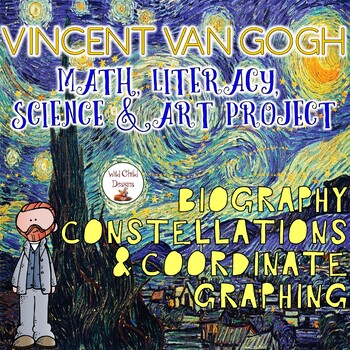Coordinate Graphing Math, Art, Literacy & Science Project
- Zip
What educators are saying
Description
The Vincent Van Gogh Coordinate Math, Literacy, Science & Art Project is a multi-disciplinary project. Students read a Van Gogh biography and quotation biography, develop a theory about Vincent based on his biography and his own words. They view "Starry Night" and engage in a visible thinking routine to explore the painting.
They read a nonfiction article about constellations, complete a graphic organizer to review main idea and supporting detail concepts. They also research constellations and the myths about them.
After reviewing coordinate graphing concepts, students learn to apply rules to coordinates. By influencing the X or Y axes, they can change the size of their lines. They practice this skill and notice how their line changes.
Finally, they are given a real world situation in which they are contracted to created a Van Gogh-inspired art piece using a real constellation. They choose one of their researched constellations, graph it and record the coordinates they used. Then their employer sends them a letter stating that it needs to be double the original size that was communicated. Students apply two rules (X * 2) and (Y*2) to accomplish the task. They cover their coordinate graph using oil pastels or crayons, and cut a night time silhouette to mimic Van Gogh's village in the painting.
The project ends with a student reflection!
Here's what you get with this download:
1. 7 pages of Teacher Talk directions, tips, and photos.
2. 2 page biography (colored).
3. 2 page biography (black and white).
4. A GORGEOUS quotation biography (6 pages, colored).
5. 2 black and white reader response sheets.
6. A copy of the "Starry Night" painting.
7. 1 black and white art response sheet.
8. 1 black and white constellation nonfiction article.
9. 1 black and white main idea/supporting details student response sheet.
10. 10 black and white (with minimal color) constellation cards.
11. 4 black and white coordinate graphing student sheets.
12. 3 answer keys
13. 2 black and white constellation data table and rule sheet.
14. Colored Young Artist Assignment sheet.
15. Black and white Young Artist Assignment sheet option.
16. 1 postmarked employer envelope and letter. (minimal color)
17. Colored Young Artist Customer Request Assignment sheet.
18. Black and white Young Artist Customer Request Assignment sheet option.
19. 2 student reflection direction pages (one colored, the other black and white).
20. 2 student reflection pages (one colored, the other black and white).
21. 10 black and white 11" X 17" landscape photos for silhouette tracing.
22. 1 black and white 11" X 17" coordinate graph
23. 1 (8 1/2" X 11") coordinate graph, black and white.
Looking for more ways to practice this coordinate graphing skill? You should check out this game: https://www.teacherspayteachers.com/Product/Math-Game-Dueling-Rules-Coordinate-Graphing-for-Upper-Elementary-4800728





